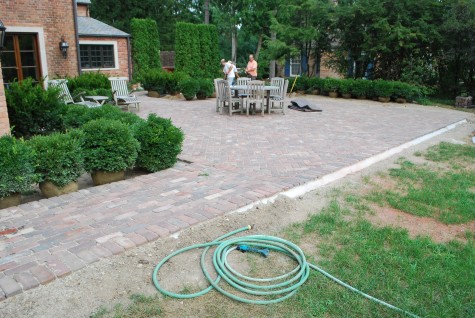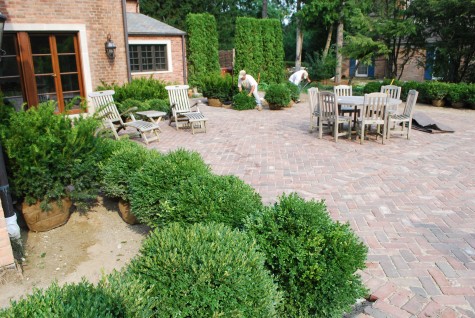There is a stage in the design and development of any project where it seems like a good idea to take the lines, shapes and descriptive words off the page of a drawing, and see what those lines look like-standing up. This idea is on my mind, as I saw a scale model today of a house a client will build this coming spring. Even the elevation changes of the property were represented by stacked sheets of thin balsa wood, cut into the curves that represent the actual existing grade. Given how pleased I was to see this 3-D representation, I can appreciate how a client may need something from me that transforms lines on a page into volumes and shapes. What will this look like-a completely legitimate question. It is simply human nature to want a window that reveals what is to come before we get there.
Smaller projects do not have a budget that includes the time it takes to build a scale model. Frankly, few projects call for that. Any client who does not mind my sharpee marker sketches drawn against a panoramic view of their house and property gets virtually the same thing as a model-just a rough version. I am not interested in the elegance and polish of a presentation-I am interested in understanding. But certain issues cannot be dealt with on paper, or with a model. An outdoor space could not be less like a drawing on a page. A real space can shred a drawing and demand what never crossed your mind.
 These old street paver bricks made in Ohio circa 1920 are anything but uniform. Laying brick in a herringbone pattern requires great skill and planning, so the pattern does not drift. Albaugh Masonry is known for their ability to beautifully handle a difficult installation-but these irregular bricks were proving next to impossible. This kind of trouble you might anticipate on paper, but reality is all about standing in a space, trying to make everything work.
These old street paver bricks made in Ohio circa 1920 are anything but uniform. Laying brick in a herringbone pattern requires great skill and planning, so the pattern does not drift. Albaugh Masonry is known for their ability to beautifully handle a difficult installation-but these irregular bricks were proving next to impossible. This kind of trouble you might anticipate on paper, but reality is all about standing in a space, trying to make everything work.
My cliennt-she is committed gardener. She stood in this space for days, plan in hand, working with Albaugh to work things out. Understanding between a designer, a client and a tradesperson makes for a great outcome. The suggestion from Albaugh that the terrace be configured in 9 smaller herringbone blocks of equal size, separated by a soldier course, was a good one. They felt they could keep the herringbone dead on given this design. God knows they tried to get those hand made bricks to work out every direction over 900 square feet. Who knows how many times this group sorted and resorted these old bricks, in order to get a surface that was true and square.
 The late day sun slanted across the terrace reveals the beauty of the brick-and the installation. As this home was built in the 1920’s, this final choice of a terrace material makes a great run at convincing a viewer that it had always been there. Choosing materials on this basis has been of interest to this client in every phase of the landscape renovation. Many plants original to the house were kept, or heeled in until a spot could be made for them. Any passionate gardener understands what a whomping lot of work this is.
The late day sun slanted across the terrace reveals the beauty of the brick-and the installation. As this home was built in the 1920’s, this final choice of a terrace material makes a great run at convincing a viewer that it had always been there. Choosing materials on this basis has been of interest to this client in every phase of the landscape renovation. Many plants original to the house were kept, or heeled in until a spot could be made for them. Any passionate gardener understands what a whomping lot of work this is.
 Changes made on site have a way of turning the rest of the world up side down. There is a part of me that so admires the math. Change a floorplan or terrace so much as 6 inches, the entire space is affected. My love of the math aside, making everything work is my idea of successful design.
Changes made on site have a way of turning the rest of the world up side down. There is a part of me that so admires the math. Change a floorplan or terrace so much as 6 inches, the entire space is affected. My love of the math aside, making everything work is my idea of successful design.
 We began the landscape installation today. How everyone involved would make everything work was the order of the day. That moment when an installation begins is the most intense work for the lot of us. A client, a masonry contractor, an irrigation specialist, a designer, a landscape company-there are lots of voices that need to tune up, and figure out how to be in harmony with one another.
We began the landscape installation today. How everyone involved would make everything work was the order of the day. That moment when an installation begins is the most intense work for the lot of us. A client, a masonry contractor, an irrigation specialist, a designer, a landscape company-there are lots of voices that need to tune up, and figure out how to be in harmony with one another.
 The art of communication-in my opinion, the most difficult art. Paintings, sculpture, crafts, decorative arts-they are all about the vision of a particular and singular artist. Landscape design is all about a successful and fluid relationship between a client, designer, and tradesperson. I thrive on this.
The art of communication-in my opinion, the most difficult art. Paintings, sculpture, crafts, decorative arts-they are all about the vision of a particular and singular artist. Landscape design is all about a successful and fluid relationship between a client, designer, and tradesperson. I thrive on this.



Very beautiful and well done installation by Albaugh Masonry. The 1920’s brick (I am aware of the difficulty of these bricks) add so much to the design and original structure. They are well worth the effort cost and headache. You should have showed the model and your panoramic marker sketches. Many are unaware of how a model or hand drawn rendering can bring a project to life. Even more so than a 3-D CAD model or computer elevation drawing.
I have just left the clients house this evening and am still thrilled at the out come of the patio. I am even more excited after Deborah’s team installed the lushest green plants I’ve ever seen.
This project was a passion of mine from the beginning. I have always loved the reclaimed bricks that were chosen. They are a piece of history that has strength in color size and texture. They represent a time when if you were not sure you just made something thicker or stronger. Instead of today when everything is made to just barely withstand its use. I then have to commend the owner on possibly being a little leary of the 9 square pattern at first but then taking the leap. I had to make an honest comment that I was holding my ground on what I thought would look the best but in the end I was spending their money.
A credit to Deborah Silver and the Client for creating a project that subtly takes your breath away without going over the top.
Thank you
Scott A. Albaugh